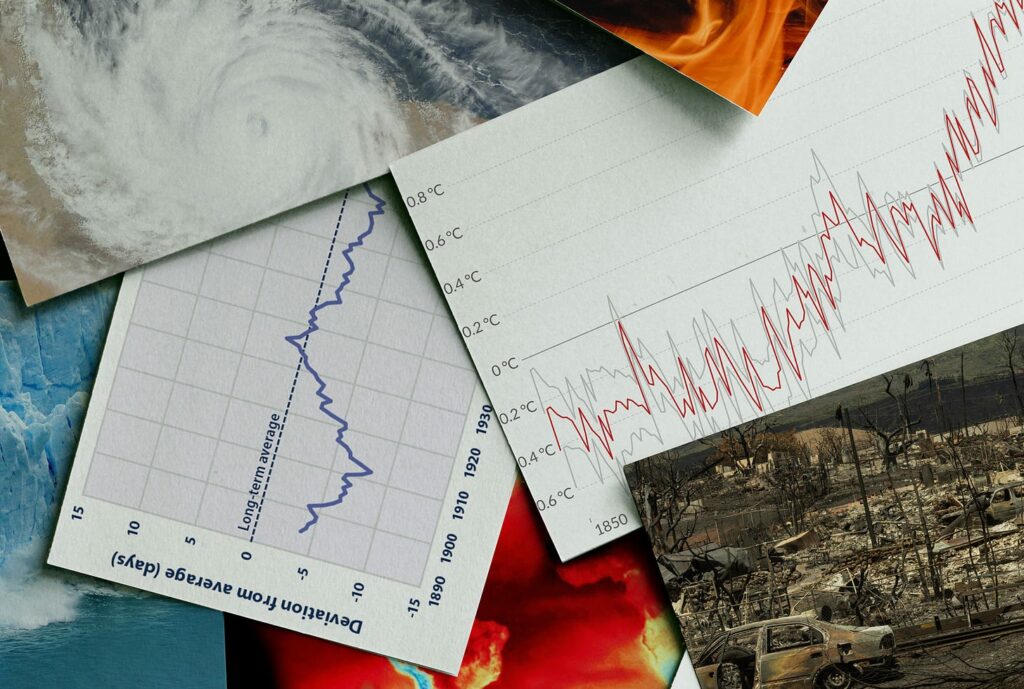It’s hard to know what to make of MSN’s news aggregator. We long ago conceded that it’s not overseen by the gimlet-eyed editors of yore with porkpie hats, mickeys in desk drawers and brusque contempt for nonsense. Yet amidst all the foolishness on climate and many other subjects, MSN does sometimes by accident or design pass on useful contrarian views. For instance “14 Ancient Climates That Challenge Today’s Predictions”. Indeed. Because for all the abuse we get about how people who know about the past can’t possibly form opinions on Earth’s climate, you really do have to know something about history to understand it. Or indeed to be an effective alarmist because if your theory cannot deal with counterexamples it’s worthless. As the story originally from Weather-Fox says, “For every dire warning or confident forecast today, there’s a surprising twist from Earth’s deep past that leaves scientists scratching their heads – and weather lovers like us utterly fascinated.” And that attitude of fascination with evidence, theories and surprises is what it takes to make sense of the world including climate.
Before we get to those “surprising” twists, or not so surprising to those who know history, let us drive home a crucial point about arguing. Not in the sense of quarrelling. In the sense of debating a point honestly and effectively in the belief that when two ideas meet on a level playing field, the victory of either is a victory for both debaters, one vindicated and the other saved from error. And that point is that if you do not address the strongest arguments on the other side, the audience is liable to conclude that you do not know them and are a fool, or know you cannot answer them and are a rogue.
This conclusion may not upset your claque. Indeed they may applaud all the louder as you seek to win by underhanded means. But it will upset the reasonable audience you need to convince. That said, let us consider that article’s opening “Did you know that Earth was once as hot as a pizza oven, or that entire continents shivered under mile-thick ice sheets?”
Why yes. You knew the latter. Maybe not the former; perhaps you could not unprompted state the temperature within a pizza oven. But you knew about the woolly mammoths they use to illustrate their first slide, right? And why these elephants grew fur? Brrrrr.
The piece, by the way, also sets up with “these astonishing ancient climates hold clues that can rewrite what we think we know about our planet’s future.” Which assumes everyone thinks they know it used to be nice and cool but will soon be wretched and hot. Arguably everyone does not think so. But it’s certainly the orthodoxy so let’s see what they manage to do to it.
Oh dear. Their first is the “Snowball Earth” geologists strongly suspect existed about 700 million years ago, fortunately before the Cambrian Explosion of multicelled life which it would certainly have snuffed out had it come later, when:
“Ice reached the equator, and global temperatures plunged so low that the oceans themselves nearly froze solid. This wasn’t just a long winter—it lasted millions of years. Life barely clung to survival, hiding deep in the oceans or in volcanic hot springs.”
Talk about climate change. And apocalypse. So tell us how CO2 caused that one? As the piece itself says “This period challenges today’s climate predictions by showing just how drastically and unexpectedly our world can change.” And one thing we strongly dislike about climate alarmism is its denial of climate change… in the past.
Next we get, indeed, the Cambrian Explosion in:
“a sweltering hothouse. The Cambrian period saw temperatures soar far higher than anything we experience today, with ocean temperatures reaching up to 40°C (104°F). This was the age when complex life suddenly burst onto the scene. Instead of wilting in the heat, ancient creatures like trilobites and the first fish flourished. The wild warmth of this era suggests that life can adapt to extremes much more dramatic than modern predictions usually account for, raising questions about what’s possible in the future.”
We’d go a bit further. Adapt isn’t quite right, because life as we understand it, with fins and eyes and beaks and so forth, didn’t adapt to this warmth, it happened during it and arguably because of it. Not that we want the planet back at 40°C, you understand. But when we hear that a half-degree rise will kill coral, don’t believe a word of it.
Next things get chilly again, with the Ordovician glaciation around 450 million years ago. Which they do in fact blame on “falling carbon dioxide levels and the positioning of continents” before chucking the latter onto the rubbish heap of history and saying “This period highlights how even small changes in greenhouse gases can have massive, sometimes unpredictable, impacts.” But it doesn’t because, ahem, atmospheric CO2 seems to have risen sharply just as temperature fell off the table in the Ordovician. It’s kind of important to the story.
They also blame the Devonian transition from warmth to cooling to the appearance of trees and forests which:
“sucked carbon dioxide from the air, cooling the planet and eventually triggering another ice age. The Devonian is a powerful reminder that life doesn’t just adapt to climate – it changes it.”
Well, up to a point, Lord Copper. That “eventually” is about 80 million years later than the appearance of trees, and at least 50 million years later than the fall in CO2 that follows an upsurge in it.
The piece goes on desperately linking CO2 to everything, including the “Great Dying” at the end of the Permian about 252 mya (“million years ago”) due this time to heat not cold. It says “Volcanic eruptions pumped vast amounts of greenhouse gases into the atmosphere, causing temperatures to spike and oceans to lose their oxygen.”
Again, not really. CO2 did rise some 10 million years before temperature did. But the temperature only got back to its more or less usual level while CO2 never got near its early Devonian levels. And in this supposedly uninhabitable world, because temperature stayed high, the dinosaurs appeared and flourished.
Yes, flourished. The piece bewails Triassic droughts. But dinosaurs and early mammals coped.
Then you get what the article calls the “Jurassic Super-Greenhouse: Swamps and Warm Seas”. So everybody died, Dave? Heck no. Never mind that silly old Permian where high CO2 meant high temperature meant high mortality:
“The Jurassic ‘super-greenhouse’ shows a world where high carbon dioxide didn’t spell disaster for all life, but instead fueled incredible biodiversity.”
Then you had forests at the poles in the Cretaceous, the Paleocene-Eocene thermal maximum (“one of the closest ancient analogs to today’s rapid climate change, but its causes and effects are still hotly debated”), and… what’s this? Oh dear:
“Around 34 million years ago, Earth changed course again. Temperatures dropped, and Antarctica became shrouded in ice for the first time. Sea levels fell, and new cold-adapted species evolved. The Oligocene cooling is a puzzle because it happened even as carbon dioxide levels were still relatively high.”
Only a puzzle if you insist that CO2 drives temperature regardless of the evidence. Including the evidence that:
“The Miocene epoch, about 23 to 5 million years ago, brought a warm, stable climate that encouraged the spread of vast grasslands. Gigantic mammals like mastodons, saber-toothed cats, and early horses roamed these plains. Interestingly, this warmth happened with carbon dioxide levels similar to today’s.”
Ahem. Isn’t CO2 meant to be the control knob on the planetary thermostat? If so, better call an electrician because:
“Just 3 million years ago, during the Pliocene, global temperatures were 2-4°C warmer than today and sea levels were up to 25 meters (80 feet) higher. Polar ice caps were much smaller, and lush forests grew in places now covered by tundra. The Pliocene is especially interesting because Earth’s carbon dioxide levels were close to what we see now.”
Whereupon we got another ice age, the Pleistocene, with repeated glaciations and interglacials, of which the article declares dogmatically:
“These repeated freezes weren’t triggered by greenhouse gases, but by subtle shifts in Earth’s orbit and tilt – tiny changes with massive consequences.”
Then the Younger Dryas, “a powerful warning that abrupt shifts can still happen.” And thus a refutation of the frequent ignorant alarmist claim that the speed of change today is unprecedented though the piece doesn’t dwell on that aspect. Likewise, it is very grudging on the more recent past:
“Around 9,000 to 5,000 years ago, Earth enjoyed the Holocene Climate Optimum—a warm spell that saw temperatures higher than today in many regions.”
In many regions. For instance the Earth. But no. It mustn’t be. Hence:
“From about 950 to 1250 AD, Europe and parts of the Northern Hemisphere experienced a warm phase known as the Medieval Warm Period. Temperatures were high enough that vineyards thrived in England, and Norse settlers farmed in Greenland. While not a global phenomenon, this regional warmth remains puzzling to scientists.”
Not a global phenomenon. Just present from Europe to the Americas to China to Antarctica. Still, you have to be careful what you say. Despite which the piece then blurts out:
“Between the 14th and 19th centuries, much of the world cooled during the Little Ice Age.”
But if it wasn’t warm, why did it have to cool to get chilly? After ignoring the fact that the Dust Bowl was characterized by heat as well as drought, the article tries to take back much of what it said with:
“The temperature rise of the last 100 years is both familiar and alarming. Global temperatures have climbed about 1.2°C (2.2°F) since the late 19th century, mostly due to burning fossil fuels. What makes this period stand out is not just how warm it is, but how fast the change has come. Ancient climates remind us that Earth has been both much warmer and much colder, but rarely has it changed so quickly.”
Still, we thank them for putting so much on the table that alarmists cannot with decency or prudence ignore, and in our view also cannot explain. And for underlining that when it comes to climate, you need history to avoid being an ignoramus.


